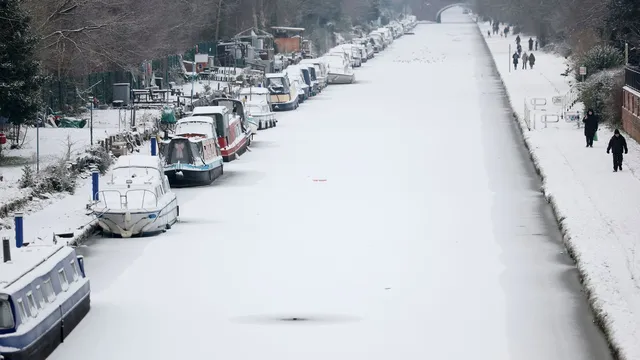
Travel chaos looms as UK faces brutal cold and warning signs
2025-01-09 21:44- The UK has been experiencing an extreme cold snap with temperatures falling as low as -20C.
- Travel disruptions have occurred across various transport sectors due to heavy snow and icy conditions.
- Officials warned of a potential blackout as electricity demand soared amid the ongoing severe winter weather.
Express your sentiment!
Insights
In the UK, residents faced hazardous winter conditions due to plummeting temperatures reaching as low as -20C in some areas. The Met Office issued multiple yellow weather warnings for ice and snow, covering significant regions, including Wales, Northern Ireland, and parts of England, which caused major travel disruptions. Consequently, Manchester Airport temporarily closed its runways, impacting flights further. Amid these challenges, the National Energy System Operator alerted that Great Britain was close to experiencing blackouts, pleading for extra electricity generation as demand soared, highlighting the strain on the grid during such extreme weather conditions. The extreme cold wave, which persisted over several days, created a snow blanket across the country, leading to travel chaos as roads became impassable and schools were forced to close. Rail services were disrupted, with Transport for Wales suspending some lines due to damaged tracks. Meanwhile, icy patches posed serious hazards for motorists. The adverse weather prompted heavy demand for rescue services from car insurance providers as drivers encountered difficulties on the road. The harsh winter spell saw temperatures drop significantly, resulting in severe energy consumption as homes sought heat. The National Energy System Operator’s (NESO) warnings underscored the risks of relying on weather-dependent electricity generation and the precarious nature of energy supply during peak demand periods in winter. It reassured consumers that, although the situation was critical, there was no imminent risk of blackouts, yet the need for continuous monitoring was emphasized. Energy experts warned that this situation should serve as a wake-up call regarding the vulnerabilities in the energy market. As temperatures were expected to rise slightly with milder air pushing in from the southwest, the situation would gradually improve. The potential for delays in travel would continue to be a concern during the transition from severe cold to more temperate conditions. Authorities remained vigilant, with updates being provided to the public on forecasts and warnings to ensure safety and preparedness in the face of the ongoing winter conditions.
Contexts
In January 2025, England emerged from the festive season enveloped in a shroud of cold air. The New Year began with heavy clouds and the promise of rain, as forecasters warned of unsettled conditions approaching from the north. As the days progressed, temperatures slipped into the low single digits during the day and plummeted below zero at night, casting the nation into a wintry grip. Residents wrapped themselves in warm clothes, rubber boots, and mittens, bracing for what the weather would bring next. On January 1st, rain swept across London, a prelude to snow that would soon blanket the northern regions of England. Citizens navigated busy streets under umbrellas, noticing the change in the air—a brisk reminder of winter's presence. Met Office Chief Forecaster Neil Armstrong hinted at heavy rainfall and gusty winds affecting Scotland, while southern areas held their breath for the anticipated wintry weather. As the week unfolded, rain transitioned into sleet and then snow, tantalizingly teasing those who yearned for a picturesque winter scene. By January 2nd, accumulations began in the higher regions, and excitement spread like wildfire. Snow-covered hills beckoned outdoor enthusiasts, but caution lingered with warnings about potential disruptions caused by the fierce weather. The second week brought icy chills and diverging forecasts—a battle between hopeful milder air from the Atlantic and the persistent cold fronts settling over the country. Whether drenched in rain or blanketed in snow, one thing was certain: January's capricious weather would continue to shape daily life, transforming England into a winter wonderland where warm fires and cozy gatherings became the heart of every home.